Disclaimer: I’m not a dietitian or doctor. I did not go to school to get a degree in Nutrition. Please see your doctor before starting your weight loss journey.
You can read Week One, Week Two, and Week Three to catch up.
In Week Three you focused on adding exercise. When I started my exercise program I swam a few times a week for over a month before I tackled the food portion of it. For continuity’s sake I’m tackling the food part sooner than that.
Week Four- FOOD (Sometimes the Hardest Part)

A lot of people who are overweight and obese got that way through poor habits: no portion control, eating junk food, having a fast food diet, not being AWARE of what they eat, and having food addictions. If you truly have a food addiction I really suggest a therapist or Weight Watchers…trying to tackle it on your own can be overwhelming.
I had a health scare that woke me up. Having high blood pressure and developing diabetes was enough of a wake-up call that I didn’t feel like I needed to get help to do so. I had to lose weight NO MATTER WHAT. There was no half-assing it.
Step One – Limiting/Counting Your Calories
Read this post on How to Count Calories.
If you’re doing Weight Watchers it’s the same process: counting points and staying within a range. Counting calories worked for me. It was simple. I did not track fat, carbs, sugar, etc. I just counted my calories. And I did it the old-fashioned way with a journal and a pen. I also ate a lot of processed food because I was learning how to eat portion sizes and how to count calories.
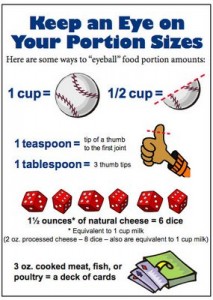
Count everything that goes into your mouth: liquids, nibbles, bites, snacks, sips. Everything. Writing it all down will break the habit of mindless munching. Being accountable, even just to yourself, will open your eyes to how you eat. For the last few weeks I recommended you become AWARE of the food you eat. Now is the time to start restricting it.
Of course the words RESTRICTING will be unnerving. It might suddenly make you feel like you want to eat everything in sight. Don’t give into this. Stay under 2,000 calories a day (for a woman) for at least one week. Really try hard. After the first week you’ll find that it’s starting to become a habit. I am so used to counting my calories now that I hardly even think about it, I just do it.
If you need a mantra, inspiring photo or a list of things to motivate you to lose weight, do it. Post a photo on your fridge. Have your list of goals in your purse with easy access.
Step Two – Eat the Same Things
My diet was pretty boring for about 1 year. In order to stay on track and lose 50 pounds I stuck to the same foods because it was simple, I didn’t cook and I knew how many calories were in what I was eating.
There is a benefit in eating the same foods, at least for awhile. Get used to eat smaller portions of food. Get used to not giving in to trigger foods and cravings. Knowing exactly what you’ll eat for every meal will take out temptation and slip-ups. It’s not a magic cure and you’ll still struggle but the hard work is worth it. You don’t have to do it forever either. This exercise is just to help form healthy habits.
For this week pick 2 or 3 different foods for each meal and alternate each day. For example: Monday/Wednesday/Friday eat 2 scrambled eggs for breakfast. Tuesday/Thursday/Saturday eat oatmeal. Sunday eat cereal or yogurt and fruit. Rotate a few different low calorie things for each meal to avoid boredom but stay within the calorie range.
Step Three – Take Photos/Food Journal
One thing about blogging is that I’ve realized just how powerful photos can be. Try taking photos of your food BEFORE you eat it. You don’t have to share it with anyone, you don’t have to post them on a blog or online. Just become aware of just HOW MUCH and WHAT you are eating.
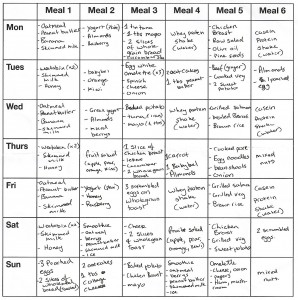
Even now, at 143 pounds, after 3 years of maintaining 100 pounds lost–I can still slip up. Sometimes I don’t even notice that I’ve been LAZY about portion sizes until I write the blog post about dinner and see the photos. OOOPS. Remember the “how many ounces of steak is a serving?” debate I had with Michael? Yeah. That was me having eyes bigger than my stomach.
It’s a great idea to look at the photos before eating, as well.
Step Four – Eat Portion Sizes
I had no idea what a portion size was. When I was 250+ and saying “I’ve tried everything and CAN’T lose weight” I was eating 3-5 times the food I should. Portions sizes are always going to be something I struggle with.
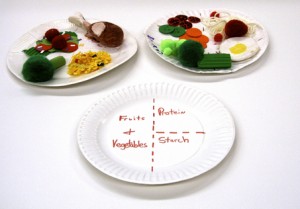
I love that photo. Half the plate should be fruits and vegetables. Filling up on high fiber foods like steamed broccoli, peas and carrots, mashed cauliflower–whatever you prefer–will help prevent overeating. Check out this awesome slide-show about portion sizes at the Mayo Clinic.
In order to learn how to eat portion sizes I ate Lean Cuisines for dinner every night for a long time. I’d have around 400 calories in the frozen meal plus a small salad. That’s how I learned what the “right amount” of food to eat was. I also measured and counted everything. If I was having some Wheat Thins I counted 14 crackers out and that was it. Sure the processed food wasn’t the healthiest thing to do but it worked for me!
Dish up servings sizes onto the plate and then eat it slowly. Remember that eating at restaurants will be detrimental to your weight loss. No restaurant dish is one serving. It’s often 3x the amount of food we should be eating.
- Enjoy the food. Eat it slowly, savor it.
- Don’t go back for seconds. No buffet style eating!
- Try eating HALF of things. Half a sandwich with a salad. Split a burger with a friend.
- Don’t eat from the package. Measure out the serving size, put the package away and eat the serving.
- Eat SMALL snacks every few hours. Carrots, plain yogurt, cottage cheese, an apple, etc. The trick is to not starve yourself and then binge.
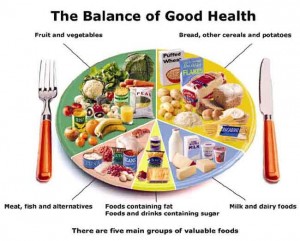
One tip I use for figuring out servings sizes: A serving size is never as much food as you WANT to eat!
QUESTION: How are you doing on your weight loss program? Have you followed any of the steps I suggested?
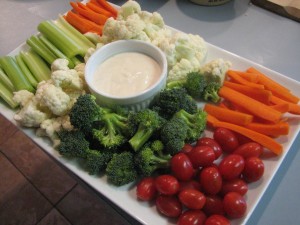
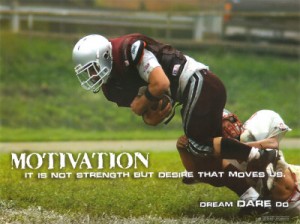
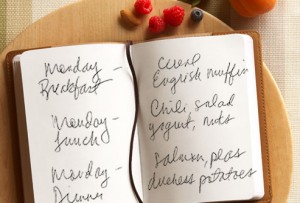
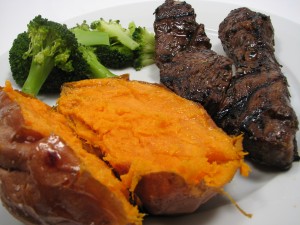
Lisa
I am glad to see this week’s topic! This is something that I struggle with. When I did Weight Watchers 10 years ago I was working and single. I found a combo of foods I liked and ate the same things over and over and over. I found exercise that I enjoyed and did the same things daily (with variety on the weekend). I consistently lost 2 lbs a week. Now I’m older, married and a stay at home mom and I’m having a hard time.
I’m exercising like crazy, eating less and eating healthier but I’m not losing weight. My body shape is changing. So, I don’t know if I’m not getting enough food – based on the equipment info, in exercise this morning I burned off more than I ate for breakfast – or if I need to get into a set rotation of the same foods to get better control.
Lisa Eirene
It’s so much easier to lose weight on your own when you’re in complete control.
I’m not a dietitian but you can email me and we can talk about what you eat now if you want. Sometimes an extra set of eyes help. 🙂
Vince Neal
I’m a guy with pretty good muscle mass so maybe my approach is atypical and not for all. But I am 50, so I’m sure my metabolism is nowhere near what it used to be. I think that by far, the best advice I’ve ever heard for losing weight and adopting a healthy eating lifestyle is to only eat when you’re hungry. I know this goes against the CW of “don’t skip meals” and “eat 5 smaller meals” every day. By adopting a strategy of only eating when I’m hungry, I actually end up skipping dinners occasionally during the work week and often skipping breakfast and lunch on the weekends. Bottom line – I’m eating a lot less food than if I forced myself to eat 3 square meals a day or 5 smaller meals a day. I am not, by any means, involved in some self-punishing, ascetic lifestyle. I found that after I had reduced my food intake via very small portions or skipping meals entirely, my hunger was reduced as my body adapted.
Only eating when you’re hungry may sound alien to many but we, as a society, eat far more food and calories than we need. Once you start to reduce the amount of food you eat, it becomes much easier for you to get in contact with your “actual hunger” as opposed to your “perceived hunger.” And, you’ll find it significantly of a lesser nature than you thought.
Again, this may go against the CW, but one eating method that has been found to be very healthy in several different ways is intermittent fasting…i.e not eating for 24 hours (or more). This is said to have very significant benefits including improvement in one’s cholesterol metrics and life expectancy. To me, that’s a direct message that we are simply eating far more than we need and far more than we should. Just food for thought…; )
Lisa Eirene
It sounds like what you’re more interested in is Intuitive Eating. That way of eating doesn’t necessarily promote fasting but it does promote listening to your body and eating when you need to. I do a mixture of Intuitive Eating and Calorie Counting. I know for me that counting my calories is a must to stay on track. But the “listening to my body” part of IE works really well for me too.